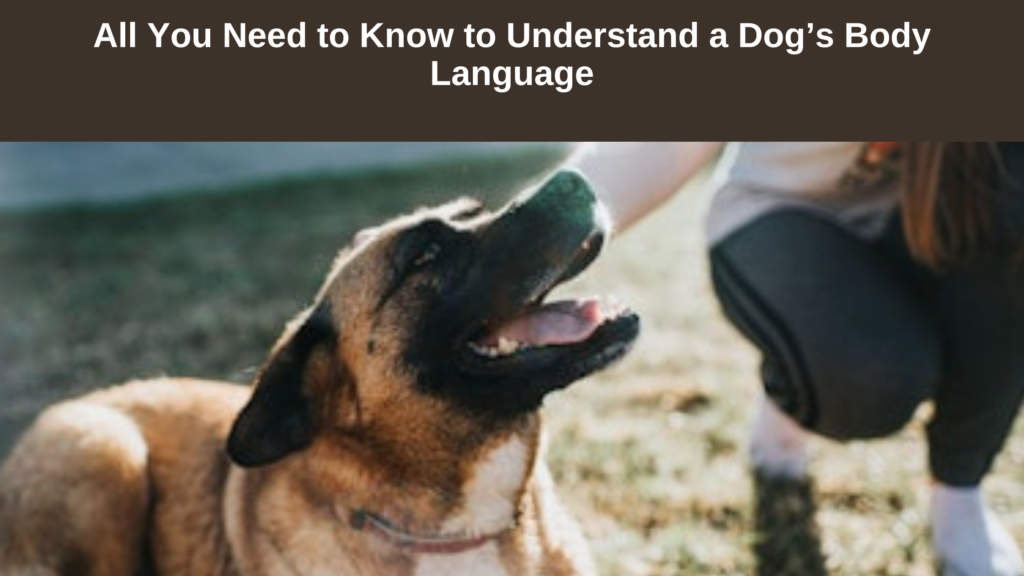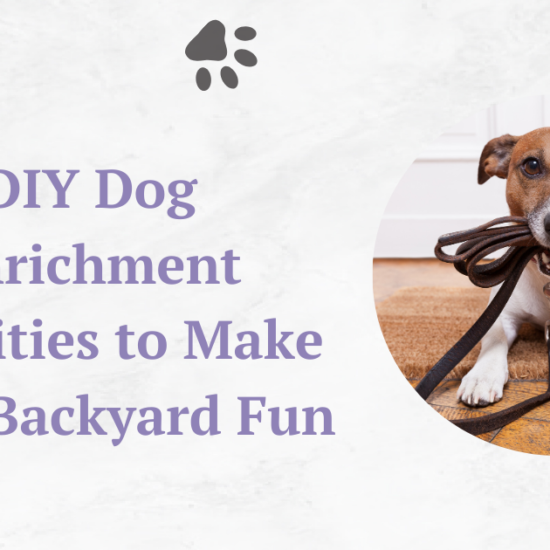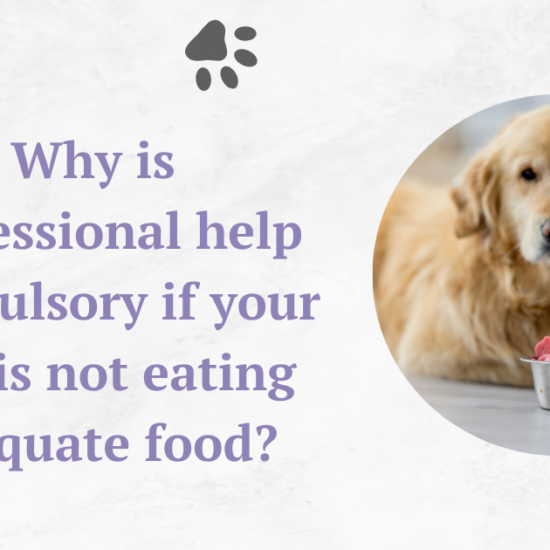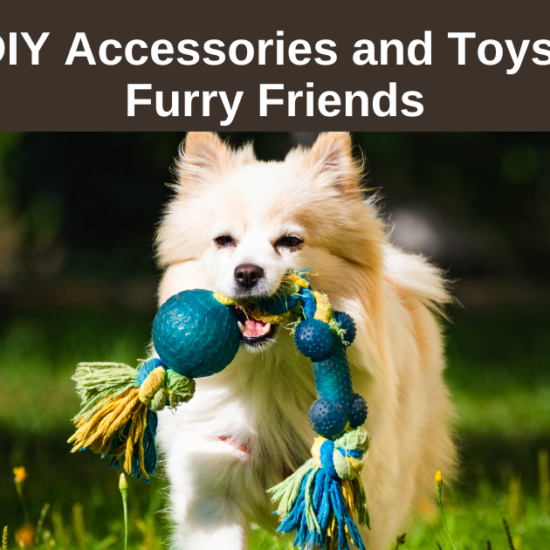Dogs have always been called “man’s best friend,” and it’s not just because they’re cute and loyal. Dogs are great at expressing themselves.
Table of Contents
Introduction
They use a complex system of body language and sounds to show how they feel, what they need, and what they want. Understanding dog’s body language can help humans and dogs get along better, make training easier, and encourage people to take care of their pets. In this detailed piece, we’ll dive into the fascinating world of dog body language.
Understanding Dog Body Language

Dogs are known for being able to express themselves to people and other animals, mostly through their body language and sounds. The tail wag is probably the most well-known of these signs, but it’s important to remember that not all tail wags mean a dog is happy. Understanding dog body language, such as the tail, ears, eyes, mouth, and stance, is important for being a good pet owner and having good relationships with our furry friends.
4 Kinds of Tail Wagging in Dogs and Their Meaning
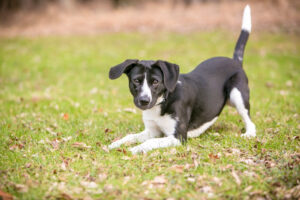
- Tail Held High
A moving tail that is held high often means that the animal is confident and happy. It’s the classic picture of a dog who is happy, confident, and ready to play. When a dog’s tail is up high, it’s usually a good sign that they’re in a good mood and ready to meet new people.
- Low Wag
On the other hand, a low wag can mean submission or doubt. When a dog puts its tail between its legs and wags it low, it usually means that it is scared or giving up. They may be worried or uncertain about what’s going on, so it’s important to approach them carefully and gently.
- Slow Wag
A slow, deliberate wag could mean that you are careful or interested. When a dog slowly wags its tail, it might be checking out a new place or situation. It’s a way of saying, “I’m interested, but I’m not sure what to make of this yet.” It’s important to give these dogs space and time to adjust.
- Fast Wag
A fast wag can mean that a dog is excited or upset. When a dog wags its tail quickly, it means it is very excited. This can be a sign that the dog is excited about something fun or looking forward to a treat. It can also be a warning sign if the dog feels upset or threatened. Pay attention to other signs of body language to figure out what’s going on.
3 Types of Ear Movements in Dogs and Their Meaning

Often overlooked, ear movements are a major part of understanding dog body language. The ears of a dog are like antennas that are always tuned to their surroundings and feelings. When approaching a dog, especially one you don’t know, it’s important to know where its ears are.
- Forward Ears
Ears that stand up and face forward are usually a sign of attention or interest. When a dog’s ears are up and looking forward, they are paying close attention to what is going on around them. This stance is often a sign of interest and a willingness to explore or express themselves.
- Flat Ears
Ears that are flat against the head may be a sign of fear or submission. When a dog puts its ears flat against its head, it is trying to make itself look smaller and less dangerous. This is a clear sign of pain or submission, and a gentle, non-threatening approach is the best way to deal with it.
- Backward Ears
Backward ears can be a sign of nervousness or anger. When a dog pins its ears back against its head, it may be showing fear, nervousness, or even a willingness to fight if it feels trapped. When this happens, it’s important to give the dog a lot of room and avoid making it even more upset.
3 Kinds of Eye Language of Dogs

People often say that a dog’s eyes are the “windows to the soul” because they show a lot about how the dog feels. Which makes eyes a major part of understanding dog body language.
- Relaxed Eyes
A calm and happy dog usually has soft, relaxed eyes. When a dog’s eyes look soft and their face looks relaxed, it means that they are happy and at ease where they are. These are the eyes of a dog that is happy and at peace.
- Bigger Pupils
Pupils that are bigger than usual can be a sign of excitement, fear, or pleasure. Just like in people, a dog’s eyes can get bigger when it feels different things. When they are excited, scared, or more aroused, their pupils can get bigger. It’s important to combine it with other signs of body language to figure out what’s going on.
- Staring
A long, unblinking stare can be seen as a challenge or a sign of violence. In human relationships, direct eye contact is often a sign of confidence and trust. In the world of dogs, however, it can mean something different. Most of the time, it’s best not to stare at a staring dog for too long and instead make soft eye contact to show friendliness and respect.
3 Types of Mouth and Lip Movement in Dogs and Their Meaning

Dog’s mouth and lip movements are also a big part of understanding dog body language.The way a dog moves its mouth and lips can tell you a lot about how it feels and what it wants.
- Smiling
Bared teeth and a relaxed smile can be signs of submission or appeasement. This is often called a “submissive grin,” and it’s a dog’s way of saying, “I don’t mean any harm; I’m not a threat.” It’s important to see this as a friendly sign.
- Snarling
When a dog snarls, its lips curl up and it shows its teeth in a more threatening way. Snarling is a sign that a dog is unhappy or angry. It’s very important to take this warning seriously and give the dog some room. If you try to get close to or interact with a dog that is growling, it could be dangerous.
- Yawning
Even if they’re not tired, dogs often yawn when they’re nervous or stressed. Dogs may yawn to get rid of stress and show that they are uncomfortable. If you see a dog yawning over and over in the same place, it’s a sign that they may be feeling stressed or anxious, and you should try to figure out why.
3 Types of Dog Body Posture and Their Meaning

A dog’s body posture also helps a lot in understanding dog body language. The way a dog stands says a lot about how they feel and what they want to do.
- Relaxed Body
A dog with a loose body that moves around a lot is likely to be happy and nice. When a dog’s body looks relaxed and its tail is wagging, it’s easy to tell that they are friendly and at ease where they are. This is the best way to act when you want to get along with someone.
- Stiffness
A body that is stiff or tense can be a sign of fear, anger, or pain. When a dog’s body stiffens and their movements slow down, it means they are on guard or feel like they are in danger. When approaching a stiff dog, you should be careful and respect their space.
- Play Bow
When a dog drops its front end but keeps its back end up, it means it wants to play and is excited. The play bow is a traditional way to ask someone to do something friendly and fun. If you see a dog in this position, it’s a great chance to have some fun.
Understanding Dog Behavior: Dog’s Barks, Whines, Howls and Growls
Dogs are known for being loud, and one of the main ways they express themselves to people and other dogs is by barking. But it can be hard to figure out what a dog is trying to say because not all barks are the same. Let’s explore how a dog’s bark, whines, howls, and growls help us in understanding dog behavior.
4 Kinds of Dog Barks and Their Meaning

- Alarm Bark
An alarm bark is a loud, repeated sound that warns others of a possible danger. It’s a clear sign that a dog has noticed something strange or possibly dangerous in its surroundings. This kind of bark is often used to warn other dogs and people.
- Play Bark
On the other end of the scale, a play bark is a high-pitched, excited bark that dogs often make when they are playing or getting along with other dogs. It’s a happy and excited way for a dog to show that he wants to play with other dogs. Play barks are often followed by playful body language, such as wiggly movements and a wagging tail.
- Territorial Bark
Territorial bark is a deep, authoritative bark that a dog uses to defend its territory. Dogs have a strong need to protect their territory, and this type of bark is meant to scare away strangers. It shows who owns the land and reminds people that they can’t go there.
- Anxious Bark
An anxious bark is a continuous whining or howling bark that can show fear or worry. When dogs are scared or unhappy, they may bark a lot. It’s a cry for comfort and a request for help to deal with their pain.
3 Kinds of Whining and Howling in Dogs and Their Meaning

- Attention-Seeking Whine
Dogs are experts at getting attention when they want it, and an attention-seeking whine is a great example. When a dog whines to get your attention or because it wants something specific, it usually does so in a constant, pleading way. This kind of crying is their way of saying, “Pay attention to me, please!”
- Lonely Howling
Since dogs are social animals, it can be hard for them to be alone. When they howl, especially when they’re by themselves, it’s often to show that they want to be with the rest of their pack. This sound breaks your heart because it is a plea for company and comfort.
- Pain or Discomfort
Whining can also mean that a person is in pain or not feeling well. When a dog is in pain, he or she may whine to show how upset they are. It’s important to take this kind of complaining seriously and find out what’s making them feel bad, like an accident or a health problem.
2 Types of Growling and Snarling in Dogs and Their Meaning

- Growl of Play
Some dogs let out a low growl when they play. This is part of how they act when they are having fun. It can come with a moving tail and calm body language. This growl is not meant to be mean. Instead, it is a way for dogs to show how excited and happy they are when they are playing.
- Defensive Growl
A growl that is followed by other defensive body language, such as a stiff body, raised hackles (the hair along the dog’s back), or a curled lip, is a clear warning to back off. A dog gives a defensive growl when it feels threatened or uncomfortable and is ready to fight back if it has to. It’s important to take this seriously and give the dog room.
5 Keys to Understanding Dog Behavior

Understanding dog behavior through their body language, requires knowledge of more than just the different types of barks, whines, howls, and growls. Context is a big part of figuring out what a dog is trying to say. Here are some key things to consider for understanding dog behavior:
- Body Language: Always look at the dog’s body language when trying to figure out what it’s trying to say. The combination of what they say and how they act gives full picture of how they feel and what they want.
- Environment: Think about the setting and the area. Is your dog barking because it wants to go for a walk or because a stranger is coming up to your house? The situation can help you figure out why they are making noise.
- Consistency: The way the sound is made and how long it lasts can give hints. Is the dog barking a lot and in a hurry, or does it bark occasionally and calmly when it’s playing?
- Pitch and Tone: A dog’s vocalizations can show how it feels by their pitch and tone. High-pitched barks can mean that the dog is excited or upset, while low, deep growls can mean that the dog is angry or uncomfortable.
- Previous Behavior: Knowing your dog’s normal actions and sounds can help you tell the difference between how they normally express themselves to you and when they are upset or excited.
A Guide for Effectively Communicating With Dogs
Dogs have been our best friends for thousands of years, and the fact that they can express themselves to us is an important part of the special relationship we have with them. Understanding dog behavior through body language and sounds is important. So that encounters between people and dogs are safe, pleasant, and productive. In this article, we’ll look at how this information can be useful in a variety of everyday situations.
3 Things to Do When You Meet a New Dog
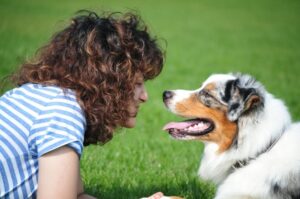
Meeting a new dog can be fun, but it could also be a tricky situation. Like people, dogs have their own traits, experiences, and safe zones. Here are some ways in which you can communicate efficiently when meeting a new dog:
- Be Observant
The first thing you should do when you meet a new dog is to pay attention. Look at the dog’s body language for a moment. Are their ears perked up, their tails moving, and their bodies calm? These are good signs that the dog might be ready to meet people.
- Respect Personal Space
Let the dog come up to you if it feels safe to do so. Don’t run up to the dog, because that can be seen as scary or dangerous. Slowly put out your hand so they can sniff it if they want to, but don’t try to touch them.
- Avoid Direct Eye Contact
Eye contact is different for dogs than it is for people. Eye contact can be a sign of trust and confidence in people, but for dogs, especially when meeting a new person, it can be seen as a challenge or a danger. Try to keep soft, indirect eye contact with the dog so it doesn’t feel weird.
- Watch for Warning Signs
If the dog shows signs of worry or discomfort, like flattening its ears, tucking its tail, or growling, it’s important to give it space and stop interacting with it. If you pay attention to these signs, you can avoid a situation that could be dangerous.
3 Ways to Train a Dog With Commands

Clear dialogue between people and dogs is the key to training that works. Dogs are very sensitive to body language and sounds, and being able to read their signs can make training much easier:
- Positive Reinforcement
Positive reinforcement is a very effective way to learn that relies on rewarding behaviors you want to see more of. To use this method well, you must be able to notice when your dog does something good and treat him at the right time. Getting to know your dog’s body language can help you find those exact times.
- Observe the Dog’s Body Language
When you teach your dog directions like “sit,” “stay,” or “come,” your dog’s body language can show if they understand and are willing to do what you ask. A dog that sits when asked and does so with a relaxed body and a wagging tail is likely to think of the order in a good way. On the other hand, if your dog seems worried or confused, you might need to change how you train him.
- Timing and Consistency
When you’re teaching, it’s very important that your cues and timing are always the same. Dogs learn through repetition and making connections, so giving them the same cues and rewards helps them understand what is expected of them. Knowing when your dog is ready to react and giving them a treat right away is a good way to reinforce good behavior.
Building a good relationship with your dog is an important part of training. By responding to your dog’s body language in the right way, you can build a good and trusting relationship with him. This makes training more fun for both of you.
Note: There might be affiliate links mentioned here. We may receive a commission if you purchase a product through an affiliate link. There is no additional charge for you. Please do your own research before making any online purchases.
Dealing with Fear or Anger in Dogs

Recognizing and dealing with a dog’s fear or rage is important for avoiding dangerous situations and making sure both people and dogs are safe.
Fear
Fear can be seen in different ways in dogs, such as trembling, hiding, barking or growling, and trying to run away. When you see these signs, it’s important to figure out what’s going on and, if possible, take the dog away from what’s making them scared.
Anger
If a dog is being aggressive, it’s important not to make them even more angry. Avoid making direct eye contact, making loud noises, or moving around quickly, all of which can make the situation worse. Instead, if it is safe to do so, put some space between you and the dog and ask a professional dog trainer or behaviorist for advice.
Seeking Professional Help

If a dog has a lot of fear or anger, it’s best to get help from a professional. A skilled behaviorist can look at the dog’s behavior, figure out what makes it act that way, and come up with a plan to deal with the problem in a safe and effective way.
3 Ways to Help Your Dog Play and Be Friends With Other Dogs

Playing and getting along with other dogs are important parts of a dog’s life that are good for its mental and physical health. To ensure that, understanding dog behavior is important.
- Positive Play Signs
There are specific dog body languages and sounds to show that they are playing with each other in a nice way. Happy play is usually shown by a wagging tail, an open body, and high-pitched barks. When you know these signs, you can encourage and join in on good play.
- Intervening in Rough Play
Playing is good for you and fun, but sometimes it can get too rough. It is important to know when play turns into fighting. When dogs play, they show anger by growling with their hackles up, biting hard, and staring very hard. In these situations, it’s important to step in and separate the dogs to keep accidents from happening.
- Socialization
It’s important for your dog’s growth and well-adjusted behavior that you introduce him or her to other dogs and people. If you know how your dog expresses themselves to other dogs and people, you can make sure that their social interactions are fun and good for them.
Understanding Dog’s Communication With Other Dogs

Dogs are social animals, and their relationships with other dogs are complicated and subtle. As dog owners, understanding dog behavior is important so that our dogs have good social situations and no fights break out. In this piece, we’ll talk about how dogs communicate with each other and how knowing how they do it can help them get along better.
Greeting Rituals
When two dogs meet, they usually have a set of ways they greet each other that have more than one reason. These routines help dogs set up a social order, find out more about each other, and decide if they will be friendly with each other or not. Here are some important parts of dog’s greeting ritual:
- Sniffing
Dogs have a very good sense of smell, and licking each other’s noses is how they learn about each other. Through smell, they can find out about the other dog’s gender, health, and even mood. This practice is often the first thing they do when they meet.
- Circling
Dogs often circle each other after the initial nose-to-nose introduction. By going around, they can see how the other dog is standing and what its body language is like. It can also be used to see if there are any holes or weak spots. Most of the time, circling is not a sign of violence but rather a way for them to get to know each other better.
- Specific Body Positions
When dogs meet each other, their body positions say a lot. When a dog walks up to you with its tail wagging and its body relaxed, it is probably in a nice mood. On the other hand, a dog that comes up to you with a stiff body, raised hackles (the hair along their back), and a high, tense tail may be showing that they are not comfortable or are ready to protect themselves if they need to.
Play Signs
Play is an important part of a dog’s life, and they have their own way of letting you know they want to play. By knowing these play signs, you can make sure that playtime stays fun and friendly:
- The Play Bow
One of the most well-known play signs is the play bow. It includes the dog putting its front end down while keeping its back end up. This way of standing is a call to play together. Dogs often wag their tails when they play, and they may even bark to show how excited they are.
- Playful Vocalizations
Dogs can be very loud when they play, but it’s important to tell the difference between that and violent behavior. Their play language can include high-pitched barks, growls, and even screams. Most of the time, these sounds are made with relaxed body language, loose movements, and no signs of aggression.
Territorial Behavior
Dogs are hardwired to defend their territory. When one dog thinks that another dog is getting too close to its territory, this can sometimes lead to fights. It’s important to know the signs of aggressive behavior:
- Marking with Urine: Dogs will often use their urine to mark their territory. This activity shows and tells other dogs that the area is theirs, both visually and through smell. When dogs come across marked territory, they may respect it or try to take it over, depending on how confident they are and how strong their territorial instincts are.
- Aggressive Body Language: A dog may show aggressive body language if it thinks that its area is being threatened. This can happen when the dog stiffens, raises its hackles, or barks or growls in a more serious tone. When this happens, it’s important to step in and stop a fight from happening.
Warning Signs of Violence
To keep dogs from fighting, it’s important to know the early warning signs of possible violence. These signs can help the owners step in and calm down tense situations before they turn into fights:
- Stiffening: A dog that quickly stiffens up and stands still may be getting ready to attack. Their muscles tighten up, and they may even stop moving for a moment before acting.
- Raised Hackles: When the hair along a dog’s back, called “hackles,” stands up, it means that the dog is very excited or upset. Raised hackles can be a sign that a dog is playing, but they can also mean that the dog is getting more serious or might be getting threatening.
- Low Growl: An aggressive dog will often make direct eye contact and tense up when it gives a low growl. Growling is a warning sound that dogs make when they don’t like what’s going on around them.
Top 3 Myths About Dog’s Body Language

Dogs are great at communicating, but there are a lot of myths and mistakes about understanding dog behavior that can lead to misunderstandings and even situations that could be dangerous. Let’s bust a few of these myths about understanding dog behavior to help people learn more about them:
Myth 1: If a Dog’s Tail Wags, It’s Always Happy
Many people think that a dog’s tail moving is always a sign that it is happy. Even though a wagging tail can show happiness and energy, it’s important to remember that it’s not the only way to tell how a dog is feeling. Consider these things to figure out what a dog is feeling:
- Context: The context of the tail wag is very important. Is the dog wagging its tail when it’s playing, when it’s meeting a new friend, or when it’s in a place it knows well and feels comfortable? Most of the time, tail wagging is a good thing.
- Speed: How fast the tail wags is important. A fast, strong wag generally means that someone is excited or riled up. On the other hand, a slow, careful wag could mean that the dog is interested, cautious, or unsure.
- Height: The dog’s tail position can also tell you a lot about its size. A high tail is usually a sign of confidence and happiness, while a tail between the legs shows fear or submission.
Myth 2: A Dog that Growls is Always Aggressive
People often think that growling is always a sign of violence, which can cause misunderstandings and unnecessary fear. Growling is a way for dogs to express themselves to each other, and its meaning can change a lot based on the situation:
- Growl of Play: Some dogs let out a low growl when they play. This is part of how they act when they are having fun. It usually comes with calm body language, a moving tail, and a happy attitude.
- Growl of Fear: When a dog is scared, it may growl. This is how they show they are uncomfortable or worried about something. It’s important to be careful when approaching a scared dog to make them feel safe.
- Warning Growl: A growl that is followed by other defensive body language, like a stiff body, raised hackles, or bared teeth, is a clear warning sign. In this situation, the dog is letting the potential threat know that they are uncomfortable and may get aggressive if they don’t back off.
Myth 3: A Snarling Dog is Always Dangerous
People often think that snarling is a sign of violence or danger, but it’s important to keep in mind that it doesn’t always mean the dog will attack. When a dog snarls, it is clear that it is unhappy or upset, but the amount of threat varies:
- Defensive Snarl: A snarl that is followed by other defensive body language, like a stiff posture or raised hackles, is a warning to back off. It means the dog feels scared or stressed and is ready to defend itself if it needs to.
- Pain or Discomfort: Dogs may snarl when they are in pain or when they are not feeling well. When this happens, they snarl to show how upset they are and to ask for help.
- Snarling Out of Fear: Dogs can also snarl when they are scared. Snarling out of fear is a reaction to perceived threats, and it’s important to make the dog feel safe to calm their fear.
5 Essential Tips For Understanding Dog Behavior
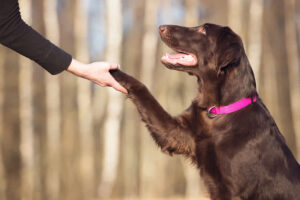
To have a good and happy relationship with our dogs, we need to be able to communicate with them well. Dogs show how they feel and what they need by how they move, what they bark at, and what is going on around them. Here are some helpful tips that will help with understanding dog behavior.
- Observe and Learn
Spend some time watching dog’s body language and communication to get to know their cues and signs. Dogs are very expressive and use their whole bodies to express themselves to each other. Look at their tail, ears, eyes, mouth, and stance as a whole to figure out what they are trying to say. For understanding dog behavior better, you need to learn how to read these signs.
- Respect Personal Space
Respecting a dog’s personal space is a key part of building trust and making sure interactions go well. Just like people have different safety zones, dogs have their own. When meeting a new dog or your own dog for the first time, approach slowly and let them come to you if they’re ready. Don’t run up to them or move in a way that makes them feel scared. Realize that not all dogs want to be touched right away, and giving them their room is a sign of respect and thoughtfulness.
- Positive Reinforcement
Positive reinforcement is a very effective way to train dogs and keep them doing what you want them to do. When your dog does something you want to see more of, like sit when you ask or come when you call, praise, treats, or love should be given right away.
Timing is the most important part of positive reinforcement. Treat your dog right after they do what you want them to do so they can make the connection between the action and the treat. This makes them more likely to understand and repeat the action.
- Professional Advice
Don’t be afraid to talk to a professional if you’re not sure about a dog’s behavior or are dealing with problems like aggression, fear, or nervousness. Professional dog trainers and behaviorists know how to look at your dog’s behavior, figure out what’s causing it, and come up with a unique training plan to fix the problem. Talking to a professional can stop things from getting worse and improve your dog’s general health.
- Socialization
Socialization is very important for your dog’s growth and behavior. Your dog will be more happy and confident in different situations if you introduce them to different people, animals, places, and things when they are young. Socialization makes it less likely that a dog will act scared or mean when meeting new people or dogs. Socialization should start as soon as possible, but it’s never too late to slowly introduce your dog to new things and places.
FAQs
Why is understanding dog behavior important?
Understanding dog behavior and body language is important for building a strong relationship, making training easier, and encouraging people to be responsible pet owners. It helps you understand what your dog is feeling, what he needs, and what he wants.
What does the wag of a dog’s tail mean?
The way a dog’s tail is positioned shows how it feels. A high wag of the tail is often a sign of confidence and excitement, while a low wag can mean submission or doubt. A slow, careful wag can mean that the dog is cautious or interested, while a fast wag can mean that the dog is excited or upset.
What can we learn about a dog’s mood by looking at its ears?
Ears that are facing forward show that the person is aware or interested. Ears that are flat against the head may show fear or submission, and ears that are pulled back can show that the person is worried or ready to defend themselves.
How can I tell if a dog’s eyes show he or she is happy or sad?
Relaxed eyes and a soft expression generally mean that a dog is happy and calm. On the other hand, dilated pupils may mean that the dog is excited, scared, or arousing. Staring at someone without looking away can be seen as a challenge or an act of violence.
What do the mouth and lips of a dog say?
A calm and happy dog may have a mouth that isn’t tense. When a dog’s mouth is relaxed and its teeth are showing, it can be a sign of submission or appeasement. On the other hand, curling your lips and showing your teeth in a more aggressive way is a warning.
What does the way a dog stands or sits mean?
A dog who is happy and friendly will have a loose body that moves around. A stiff or tense body can show fear, anger, or discomfort, and a play bow is a sign of excitement and a call to play.
What are the different ways that a dog can bark, and what do they mean?
Dogs have different barks, like alarm barks to warn of possible dangers, play barks to show how happy they are, and territory barks to protect their space. A worried bark could be a sign of fear or pain.
What does a dog’s whining mean, and why do they do it?
Dogs may whine to get your attention, show that they are lonely, or tell you that they are hurting or uncomfortable. To figure out what they mean when they whine, you need to know what is going on around them and how they are acting.
How can we tell the difference between a dog’s fun growl and an aggressive one?
Growling in a playful way is followed by calm body language, a wagging tail, and a happy attitude. Aggressive growling is often accompanied by defensive body language, such as a stiff stance and raised hackles.
How should I meet a new dog?
When you meet a new dog, pay attention to how it moves, give it room, avoid making direct eye contact, and look for signs of anxiety or aggression. Always approach slowly and carefully, and let the dog come to you if they’re ready.
Conclusion
Understanding a dog’s body language and behavior is important for a caring pet owner. Dogs have a complex way of communicating with each other that goes far beyond wagging their tails. Learning to read their signals can help people and dogs get along better and make sure everyone has a safe and fun time. We can have a loving and peaceful relationship with our furry friends if we respect their limits, meet their needs, and use positive reinforcement methods.


